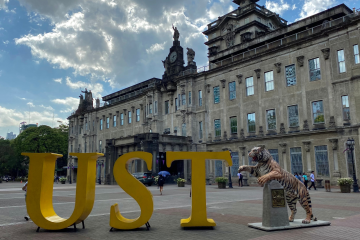SIX ARTLETS from the journalism program won in this year’s Philippine Journalism Research Conference (PJRC), announced Saturday.
The students received awards under the two categories: Academic Research and Special Projects in Feature.
Journalism senior Carlito Topacio won first place under the category of Academic Research for his study, “Covering Ground Zero: How the Philippine Media portrayed China’s role in the COVID-19 pandemic.”
“I was able to generate a theory proposing that the media’s coverage on a global outbreak’s country of origin is transformative in nature. Experiencing various “phases” in its reportage, with each phase having its own predominant focus,” Topacio told The Flame.
Topacio’s research explored the local media and how it shaped the image of the pandemic, focusing on China’s involvement in the COVID-19 pandemic, and how the Filipinos and Chinese Filipinos perceived this portrayal.
“China has been at the forefront of the public’s consciousness during the pandemic, both for good and bad reasons. I believe that the local media has played a pivotal role in that,” Topacio said in an online interview
Topacio also said that part of being a journalist is to chronicle the widespread force of East Asian countries in Philippine affairs.
“I hope that my research can help us do something that we don’t really do all that often to take an introspective look at how we report, especially on an emerging superpower such as China,” Topacio said.
Seniors Coleen Ruth Abiog and Jayziel Khim Budino won third place under the category of Academic Research for their work “A Critical Discourse Analysis of the Representation of Youth Activism under the Duterte Administration (Online News Headline).”
Their research focused on youth activism under the Duterte administration and how the online news media represent it. The results showed that online news headlines emphasized the negative in youth activism and represented them as troublemakers.
“It took us a year to complete the study. We had to read a lot of previous studies about our topic, including news about the red-tagging of youth activists,” Abiog said
Abiog emphasized that they want their study to shed light on youth and youth activism in social change.
Budino said that they picked the topic as it is close to their heart.
“As aspiring journalists, we noticed the relationship between the government’s critical view of youth dissent and how the media unconsciously or consciously amplifies it,” Budino stated.
Under the category of Special Projects in Feature, juniors Raimee Rose Arugay, Miguel Louis Galang, and Laurd Menhard Salen won third place for their article “HIV Cases, after lull in testing, are now back to pre-pandemic level.”
“We found that there’s an alarming trend in the testing, 20 percent to 25 percent of those who get themselves tested obtained positive results relatively high compared to the 10 percent to 12 percent before the pandemic set in,” Salen told the Flame.
Salen mentioned that the country had been successful in sharing awareness on HIV but it had been pushed back since the pandemic.
“We saw the need to give an update on the HIV cases during the pandemic and of course provide the public significant knowledge so that they can avoid contracting the disease,” Salen stated.
The 9th PJRC theme was “State of Journalism during a pandemic.”
The annual Philippine Journalism Research Conference (PJRC) is an extension project of the University of the Philippines Department of Journalism that started in 2012. This year’s PJRC theme was co-organized by the University of Santo Tomas. F



